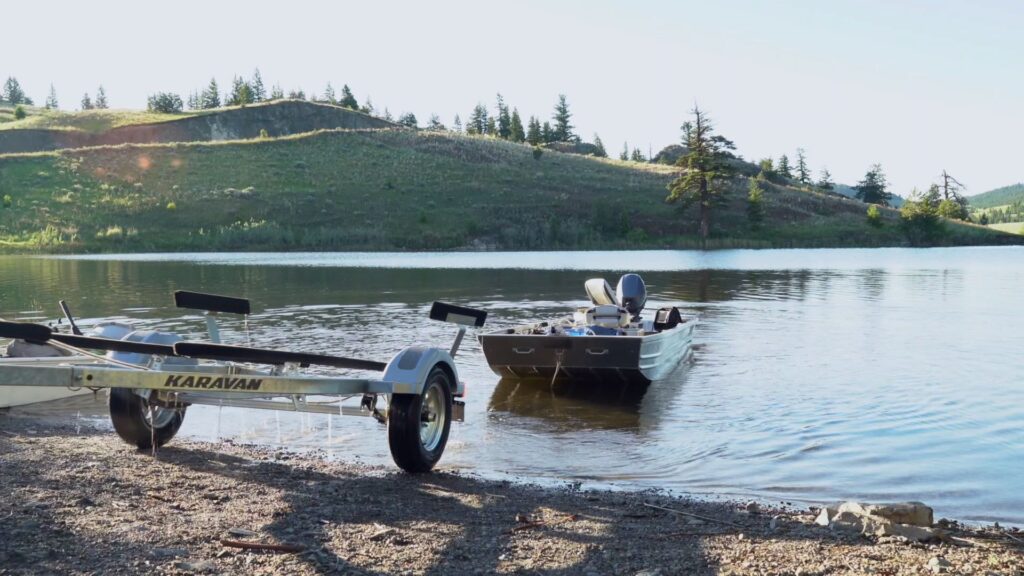What is whirling disease?
Whirling disease is caused by a microscopic parasite (Myxobolus cerebralis). The parasite enters fish through the skin and invades the head, spinal cartilage, and nervous tissue. Damage to the brain stem and spinal cord of infected fish results in the erratic, “whirling” swimming pattern for which the disease is named. When infected fish die, spores are released to find aquatic bottom-dwelling worm hosts. The worms ingest the spores and release them in a form that can infect more susceptible fish, repeating the disease cycle.
Signs of infection in fish include a blackened and/or deformed tail and skull deformities. However, these deformities are not considered proof of infection, and could be caused by injury or other diseases. Fish may also be infected with Myxobolus cerebralis and show no visible external signs. The only way to confirm infection is in the lab, by testing the suspect fish.
The parasite can be lethal in rainbow (including steelhead) and cutthroat trout, especially in juvenile fish. The severity of the disease and the mortality rate are dependent on several factors, including fish age and environmental conditions, and therefore vary from waterbody to waterbody.
Species susceptible to the disease include brook, brown, bull, cutthroat, and rainbow trout; mountain whitefish; and coho, sockeye, and chinook salmon.
Detection of whirling disease in B.C.
Whirling disease was first detected and confirmed in Canada in 2016, in Alberta’s Johnson Lake. B.C. began monitoring for whirling disease shortly thereafter in East Kootenay waterbodies, due to their proximity to Alberta. In 2023, Myxobolus cerebralis was detected in Emerald Lake, British Columbia. The whirling disease parasite was subsequently found in the Kicking Horse River, Wapta Lake, Finn Creek, and Monarch Creek. To date, Myxobolus has been detected in B.C. only within the Columbia watershed.
What is being done to stop the spread of whirling disease in B.C.?
No treatment is available for whirling disease. Currently, containment and preventing the spread of the disease are the only options.
The Canadian Food Inspection Agency (CFIA), Province of British Columbia, and Freshwater Fisheries Society of BC are continuing to test and monitor fish for whirling disease in British Columbia. Whirling disease is a federally reportable disease, through the CFIA.
Is the disease being monitored for in fish hatcheries?
Yes. Additional protocols have been put in place to prevent the spread. Staff are also taking extra preventative measures to wash and disinfect trucks or equipment used for work in the Columbia drainage.
How can boaters and anglers help prevent the spread?
As of May 17, 2024, it is illegal to transport watercraft in British Columbia with the drain plug still in place.
Anglers and watercraft owners are encouraged to practice clean, drain, and dry to prevent the spread of whirling disease and other aquatic invasive species in B.C.
Clean. Thoroughly inspect your boat, trailer and components, equipment, and gear to remove any mud, dirt, plants, or aquatic species. Pay close attention to hidden, hard-to-reach areas.
Drain. Areas that hold water should be drained at the side of the lake or river prior to leaving. This includes bilges, cargo areas, water pumps, etc.
Dry. All areas of the boat, gear, or equipment that may have gotten wet should be dried thoroughly before going into a new waterbody.
As felt-soled waders are particularly difficult to disinfect, wearing them is strongly discouraged. Instead, anglers are encouraged to use rubber-soled alternatives. They provide the same non-slip qualities, but are much easier to clean.
Never move fish or fish parts from one waterbody to another.
Is whirling disease harmful to humans?
There are no health concerns for people or other mammals swimming in or drinking water that contains whirling disease spores.
Can I still fish in the Kootenay Region?
To prevent the spread of whirling disease, all waterbodies in Yoho and Kootenay National Park are closed to watercraft and angling until March 31, 2025. Visit the Parks Canada websites for more information. All other lakes and rivers in the Kootenay Region are open for recreation and fishing at this time. However, it is always a good idea to check for in-season changes to regulations prior to heading out on the water.
Can I keep and eat fish from the Kootenay Region?
Yes. Eating an infected fish is not known to cause harmful effects. Since fish carcasses may carry the disease, it is recommended you dispose of unwanted fish parts in your solid waste system. Do not dispose of fish parts in your kitchen garburator.
For more information:
Canadian Food Inspection Agency: Whirling Disease
BC Government Aquatic Invasive Species: Whirling Disease
BC Government Media Release: Province Increases Prevention of Invasive Species
Please forward any reports or inquiries regarding whirling disease in British Columbia to [email protected]
Author: staff, Freshwater Fisheries Society of BC
